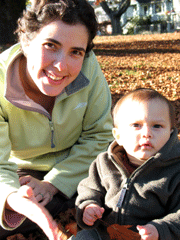
Parents, be warned: It takes only a single visit to McDonald's for your child to get hooked on the greasy stuff for life.
Okay, so that's an exaggeration. But the three-year-old son of Angela Verbrugge still remembers his one and only meal under the golden arches. Which has Verbrugge worried.
And Kyla Epstein swears if her young son Max ever wants to eat there, he'll be doing it on his own dime.
These parents aren't raging against the health detriments of fast food. Instead, they are making a conscious effort to limit the amount of branding and advertising their kids are exposed to in all aspects of their lives; what they eat, wear, watch and play with.
It's not easy. Brands are everywhere -- literally.
Disney 24/7
Genevieve McMahon says she experienced an "eye-opening" moment the first time she bought disposable diapers for her newborn daughter Imogen, who was then too small for the cloth variety her parents preferred.
"We were unpacking them to put them in her drawer and realized there were Walt Disney Winnie the Pooh characters all over them," she says.
"It was at that point when we were like, oh wow ... it's everywhere. I mean, she's not even conscious and yet here they are advertising. I'm staring at it everyday. And eventually...she's going to recognize them."
Exactly. In her book Buy Buy Baby: How Consumer Culture Manipulates Parents and Harms Young Minds, Susan Gregory Thomas explores the widespread and controversial phenomenon of using spokes-characters in advertising to young children.
She describes one study in which toddlers are shown a made-up commercial with a mouse character. The researcher's hypothesis? If the mouse was seen eating a certain kind of cracker, when given a choice later, the child would choose those same crackers.
The study didn't support that hypothesis, but what it did demonstrate is the amazing capacity of young children for character recognition. What surprised the researchers is that many children were able to recognize the mouse later, even if they didn't appear to be paying much attention to the TV screen.
Plethora of Dora
"The chief piece of learning that very young children mastered from watching characters on television was the ability to recognize them," Gregory Thomas writes.
Epstein, for one, is clearly frustrated with this kind of character prevalence. She remembers trying to find a Spanish-language picture book for Max, 11 months.
"Everything was Dora!" she exclaims, referring to the popular Dora the Explorer animated kid's show about a 7-year-old latina girl and her friends.
"I don't want all his books to all be TV characters."
Licensed characters are huge moneymakers for companies. In 2005, Winnie the Pooh earned Disney $6.2 billion in retail sales, according to Gregory Thomas, second only to the mouse.
Verbrugge believes all of this merchandising is the real problem, not necessarily the characters themselves.
"They're trying to sell kids other products, from clothing to bedding...there always needs to be something else that they're striving to buy," she says.
"It scares me when I see advertisements that showcase all these different products that show the child being engaged with a toy," she says.
"They're saying all the right things in the voiceover about baby learning and interactivity...yet you just want to take that baby and turn him around to face the mom and have her play a simple game of patty-cake."
Parents as sitting ducks
All the parents interviewed said they feel targeted by advertisers, and indeed, the desire to make one's child happy is a powerful marketing tool.
Verbrugge, who used to work as a consultant on projects related to children's online activities, says she attended many marketing conferences as part of her job.
"It taught me how sophisticated marketers are in reaching people, and more and more how integrated marketing is in everything we see and do," she says.
"I think we're seen as consumers...how much wallet share do kids have, and how much can they influence our spending."
Yet the push to buy doesn't jive with the values these parents want to instill in their own kids -- values like critical thinking, individuality and sustainable living.
Finding the balance between what their kids want, what they need and what's available is difficult, say these parents. And they are the first to admit they are by no means perfect.
Off the wagon
"The only thing we can really do is in our home environments, in the environments we choose for our children," says Verbrugge. She and her husband request that friends and family buying for their three children steer clear of plastic. But when Verbrugge's father insisted on a plastic wagon for his grandkids, she figured the item wasn't worth a fight.
Epstein and McMahon both say they make these requests as well -- and they are usually heeded.
"For his first birthday, we said gifts are not necessary, no plastic and preferably previously-owned and wearable or readable," says Epstein.
At the same time, she says Max has toys she and husband Melvin would never buy, "but he loves them and a friend passed them on."
"It's not that I want to hide him in a bubble, away from all things Disney...it's just that I want to be there to have a dialogue with him, like my parents did," Epstein says.
Gabe Epstein, Kyla's father, says he and her mother "didn't buy brand-name stuff in those days."
The retired Grade 1 teacher says he regularly saw different trends and fads sweep through the school, but in his own class and home he tried to encourage individuality.
"While it lines the pockets of large corporations, branding undermines creativity and choices, in a sense," he says.
"[Diversity] encourages the capacity to create something different."
Hemp clothes, natural blocks?
This kind of dialogue is critically important for children, says Michelle Stack, an assistant professor in educational studies at UBC.
"I'm really concerned about the fact that rarely can children engage in play or interaction that don't involve commercial or don't involve getting their parents to buy something," she says.
"It's impossible for a kid not to be exposed to massive amounts of advertising even if the TV's off all the time -- it still requires a conversation."
Stack says children need help understanding that, although they may find pleasure in TV and other media, they are designed with a purpose and often that purpose is to sell products or ideas.
Resisting the urge to spend for the sake of convenience or pleasure is difficult for parents as well (especially when toting around a baby or toddler). And, as all the parents pointed out, often the "best" choices -- natural wooden blocks or organic hemp clothing -- are also the most expensive.
"The most challenging thing about making an effort to not brand your child in what they wear, or play with...is the fact that sometimes there aren't choices and sometimes the choices are economically out of reach," says Epstein.
'Not easy'
But, as McMahon says, the best parents can hope to do is try and live the values they want their children to learn -- for their sake and for the sake of the environment.
"I think it's really important to show the down side to it too ... in the sense that it's not always easy," she says.
"It's not always easy to be a one-car family, it's not easy to limit processed foods, to try to buy locally. But I think at the end of the day, you have to live the values that you want, that ultimately you want your children to have."
Tomorrow: Cough up the Halloween candy! A mom's first person account.
Related Tyee stories:
- So You Want Me to Breed?
Fertility crisis fretting misses how lots of women really think. - Fear of Parenting
Let's see. How have I screwed up today? - Building Heart Fiber in Kids
Teaching children about giving pays off.
















Tyee Commenting Guidelines
Comments that violate guidelines risk being deleted, and violations may result in a temporary or permanent user ban. Maintain the spirit of good conversation to stay in the discussion.
*Please note The Tyee is not a forum for spreading misinformation about COVID-19, denying its existence or minimizing its risk to public health.
Do:
Do not: